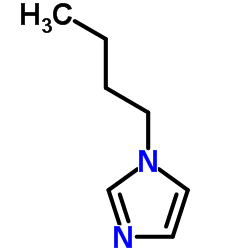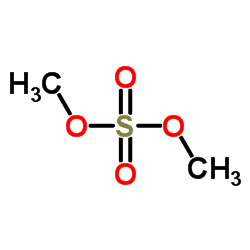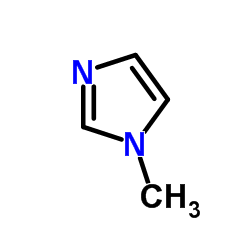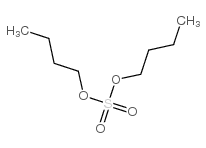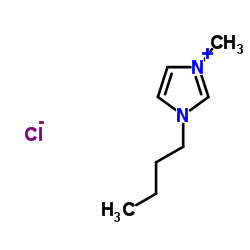1-butyl-3-methylimidazolium methylsulfate
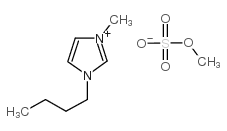
1-butyl-3-methylimidazolium methylsulfate structure
|
Common Name | 1-butyl-3-methylimidazolium methylsulfate | ||
|---|---|---|---|---|
| CAS Number | 401788-98-5 | Molecular Weight | 250.31500 | |
| Density | 1.21 | Boiling Point | N/A | |
| Molecular Formula | C9H18N2O4S | Melting Point | -4°C(lit.) | |
| MSDS | Chinese USA | Flash Point | N/A | |
| Symbol |

GHS05 |
Signal Word | Danger | |
| Name | 1-butyl-3-methylimidazol-3-ium,methyl sulfate |
|---|---|
| Synonym | More Synonyms |
| Density | 1.21 |
|---|---|
| Melting Point | -4°C(lit.) |
| Molecular Formula | C9H18N2O4S |
| Molecular Weight | 250.31500 |
| Exact Mass | 250.09900 |
| PSA | 83.62000 |
| LogP | 1.28650 |
| Appearance of Characters | liquid | yellow |
| Index of Refraction | n20/D 1.478 |
| InChIKey | MEMNKNZDROKJHP-UHFFFAOYSA-M |
| SMILES | CCCCn1cc[n+](C)c1.COS(=O)(=O)[O-] |
| Stability | hygroscopic |
|
Section 1: Product Identification Chemical Name:1-Butyl-3-methylimidazolium methanesulfonate, 98% [BMIM] [MeSO4] CAS Registry Number:401788-98-5 Formula:C9H18N2O4S EINECS Number:none Chemical Family:organic amine salt Synonym:3-Butyl-1-methyl-3H-imidazol-1-ium; methylsulfate
Section 2: Composition and Information on Ingredients IngredientCAS NumberPercentACGIH (TWA)OSHA (PEL) Title Compound401788-98-5100%no datano data Section 3: Hazards Identification Emergency Overview:Irritating to eyes, skin and respiratory tract. Primary Routes of Exposure:Ingestion, eyes, inhalation, skin contact Eye Contact:Causes moderate to severe irritation of the eyes. Skin Contact:Causes moderate to severe irritation of the skin Causes irritation of the respiratory tract with burning pain in the nose and throat, coughing, and pulmonary Inhalation: edema. Ingestion:May be harmful or poisonous if swallowed. Severe irritant to the gastrointestinal system The methylsulfate fragment may act as a poisonous alkylating agent in the human body as does dimethyl Acute Health Affects: sulfate. Irritating to skin, eyes and respiratory tract. Chronic Health Affects:No information available on the long-term chronic effects. NTP:No IARC:No OSHA:No SECTION 4: First Aid Measures Immediately flush the eyes with copious amounts of water for at least 10-15 minutes. A victim may need Eye Exposure: assistance in keeping their eye lids open. Get immediate medical attention. Wash the affected area with water. Remove contaminated clothes if necessary. Seek medical assistance if Skin Exposure: irritation persists. Remove the victim to fresh air. Closely monitor the victim for signs of respiratory problems, such as difficulty Inhalation: in breathing, coughing, wheezing, or pain. In such cases seek immediate medical assistance. Seek medical attention immediately. Keep the victim calm. Give the victim water (only if conscious). Induce Ingestion: vomiting only if directed by medical personnel. SECTION 5: Fire Fighting Measures Flash Point:none Autoignition Temperature:none Explosion Limits:none Extinguishing Medium:carbon dioxide, dry powder or foam Fire fighters should be equipped with a NIOSH approved positive pressure self-contained breathing apparatus Special Fire Fighting Procedures: and full protective clothing. Hazardous Combustion andIf involved in a fire this material may emit toxic organic fumes. Decomposion Products: Unusual Fire or Explosion Hazards: No unusual fire or explosion hazards. SECTION 6: Accidental Release Measures Spill and Leak Procedures:Small spills can be mixed with vermiculite or sodium carbonate and swept up. SECTION 7: Handling and Storage Handling and Storage:Store in a cool, dry place in a tightly sealed container. SECTION 8: Exposure Controls and Personal Protection Eye Protection:Always wear approved safety glasses when handling a chemical substance in the laboratory. Skin Protection:Wear protective clothing and gloves. Consult with glove manufacturer to determine the proper type of glove. Ventilation:If possible, handle the material in an efficient fume hood. If ventilation is not available a respirator should be worn. The use of respirators requires a Respirator Respirator: Protection Program to be in compliance with 29 CFR 1910.134. Ventilation:If possible, handle the material in an efficient fume hood. Additional Protection:No additional protection required. SECTION 9: Physical and Chemical Properties Color and Form:yellow liquid Molecular Weight:250.32 Melting Point:no data Boiling Point:no data Vapor Pressure:not applicable Specific Gravity:no data Odor:none Solubility in Water:soluble SECTION 10: Stability and Reactivity Stability:hygroscopic Hazardous Polymerization:no hazardous polymerization Conditions to Avoid:contact with air and moisture Incompatibility:strong oxidizing agents Decomposition Products:carbon dioxide, carbon monoxide, nitrogen oxides, and organic fumes. SECTION 11: Toxicological Information RTECS Data:No information available in the RTECS files. Carcinogenic Effects:no data Mutagenic Effects:no data Tetratogenic Effects:no data SECTION 12: Ecological Information Ecological Information:No information available SECTION 13: Disposal Considerations Disposal:Dispose of according to federal, state, and local regulations. SECTION 14: Transportation Shipping Name (CFR):Non-hazardous Hazard Class (CFR):NA Additional Hazard Class (CFR):NA Packaging Group (CFR):NA UN ID Number (CFR):NA Shipping Name (IATA):Non-hazardous Hazard Class (IATA):NA Additional Hazard Class (IATA):NA Packaging Group (IATA):NA UN ID Number (IATA):NA SECTION 15: Regulatory Information TSCA:Not listed in the TSCA inventory. SARA (Title 313):Title compound not listed. Second Ingredient:none SECTION 16 - ADDITIONAL INFORMATION N/A |
| Symbol |

GHS05 |
|---|---|
| Signal Word | Danger |
| Hazard Statements | H314 |
| Precautionary Statements | P280-P305 + P351 + P338-P310 |
| Personal Protective Equipment | Faceshields;full-face respirator (US);Gloves;Goggles;multi-purpose combination respirator cartridge (US);type ABEK (EN14387) respirator filter |
| Hazard Codes | C |
| Risk Phrases | R34 |
| Safety Phrases | 26-36-45 |
| RIDADR | UN 3265 8/PG 2 |
| WGK Germany | 3 |
| Packaging Group | II |
| HS Code | 2933290090 |
|
~77% 
1-butyl-3-methy... CAS#:401788-98-5 |
| Literature: Pereiro, Ana B.; Verdia, Pedro; Tojo, Emilia; Rodriguez, Ana Journal of Chemical and Engineering Data, 2007 , vol. 52, # 2 p. 377 - 380 |
|
~% 
1-butyl-3-methy... CAS#:401788-98-5 |
| Literature: Solvent Innovation GmbH Patent: EP1182196 A1, 2002 ; Location in patent: Page 11 ; |
|
~% 
1-butyl-3-methy... CAS#:401788-98-5 |
| Literature: Itoh, Toshiyuki; Ouchi, Nozomi; Hayase, Shuichi; Nishimura, Yoshihito Chemistry Letters, 2003 , vol. 32, # 7 p. 654 - 655 |
|
~98% 
1-butyl-3-methy... CAS#:401788-98-5 |
| Literature: MERCK PATENT GMBH Patent: WO2006/63654 A1, 2006 ; Location in patent: Page/Page column 19-20 ; |
|
~97% 
1-butyl-3-methy... CAS#:401788-98-5 |
| Literature: MERCK PATENT GMBH Patent: WO2006/63654 A1, 2006 ; Location in patent: Page/Page column 29 ; |
| HS Code | 2933290090 |
|---|---|
| Summary | 2933290090. other compounds containing an unfused imidazole ring (whether or not hydrogenated) in the structure. VAT:17.0%. Tax rebate rate:13.0%. . MFN tariff:6.5%. General tariff:20.0% |
| MFCD03095437 |
| 1-butyl-3-methyl-3H-imidazolium methyl sulfate |
| [Emim][MeSO4] |
| [BMIM][MeSO4] |
| [C4C1im][MeSO4] |
| Basionics(R) LQ02 |
| 1-Butyl-3-methylimidazolium methyl sulfate |
| [BMIM][MeOSO3] |
| 1-n-Butyl-3-methylimidazolium methyl sulfate |
